Incorporating Tobiko and Masago in Sushi
In this article, we will explore how to incorporate Tobiko and Masago in sushi, their distinctive features, and the advantages they offer to sushi lovers.
What is Tobiko and Masago?
Tobiko and Masago are types of fish roe commonly used in Japanese cuisine. These tiny eggs are harvested from different fish species and are known for their unique flavors and colors. Tobiko is taken from flying fish, while Masago is sourced from capelin fish. Both varieties offer a burst of umami taste and a satisfying pop when consumed.
Tobiko Features and Benefits
Tobiko stands out due to its small size and vibrant colors, making it a favorite choice for sushi rolls, nigiri, and decorative garnishes. Here are some key features and benefits of Tobiko:
- Vibrant Colors: Tobiko comes in various shades such as red, orange, green, and black, adding visual appeal to any sushi dish. The striking colors make Tobiko a popular choice for decorative purposes.
- Unique Flavor: It has a distinct flavor that balances the taste of the fish and enhances the overall sushi experience. The sweet yet slightly salty taste of Tobiko complements different ingredients used in sushi.
- Texture: Tobiko has a delicate crunch that adds a pleasant texture to each bite. The popping sensation while consuming Tobiko elevates the sushi-eating experience.
- Rich in Nutrients: Tobiko is a good source of protein, omega-3 fatty acids, calcium, and vitamins. It adds nutritional value to your sushi rolls while enhancing their taste.
Masago Features and Benefits
Masago, similar to Tobiko, is cherished for its versatility and unique attributes. Let’s explore the features and benefits of incorporating Masago in sushi:
- Delicate Flavor: Masago possesses a mild and slightly briny taste that delicately complements the fish and rice in sushi. It adds a layer of flavor without overpowering other ingredients.
- Crunchy Texture: The small eggs of Masago provide a pleasing crunch, creating a textural contrast with the softness of the sushi rice. This delightful texture makes it a popular choice among sushi enthusiasts.
- Enhanced Presentation: Masago’s bright orange or red color brings vibrancy and visual appeal to sushi dishes. Its small size allows for precise placement and artistic presentation, making sushi visually captivating.
- Healthy Nutrients: Masago is a good source of omega-3 fatty acids, vitamins, and minerals. It contributes to a balanced and nutritious sushi experience.
Incorporating Tobiko and Masago in Sushi
Now that we have explored the distinctive features and benefits of Tobiko and Masago, let’s discuss how to incorporate them into sushi rolls and dishes:
1. Nigiri Sushi:
Nigiri sushi, a classic sushi style, is a great way to showcase the flavors and visual appeal of Tobiko and Masago. Here’s how you can incorporate them into Nigiri sushi:
- Create a base of vinegared sushi rice and gently shape it into a small, oblong mound.
- Place a slice of fresh fish such as tuna, salmon, or eel on top of the rice.
- Add a small amount of Tobiko or Masago on the fish, pressing it gently to adhere.
- Serve it with a touch of soy sauce and wasabi to elevate the flavors.
2. Sushi Rolls:
Sushi rolls, also known as maki rolls, are another popular way to incorporate Tobiko and Masago. Here’s a quick guide to create sushi rolls with these delightful fish roe:
- Prepare a sheet of nori (seaweed) on a bamboo sushi mat.
- Spread a layer of seasoned sushi rice evenly on the nori, leaving a small border at the top.
- Place your desired ingredients in a row on the rice, such as crab sticks, avocado, cucumber, or tempura shrimp.
- Add a line of Tobiko or Masago next to the other ingredients for a pop of color and texture.
- Gently roll the sushi, using the bamboo mat as support, and seal the roll together.
- Slice the roll into bite-sized pieces and serve with soy sauce and pickled ginger.
Key Takeaways
Incorporating Tobiko and Masago in sushi can elevate both the taste and presentation of this beloved Japanese dish. Remember the following key takeaways while enjoying sushi with these flavorful fish roe:
- Tobiko comes in vibrant colors, adds a unique flavor, and provides a delightful texture.
- Masago offers a subtle flavor, a satisfying crunch, and enhances the visual appeal of sushi.
- Both Tobiko and Masago are packed with nutrients, adding a nutritious element to your sushi rolls.
- Experiment with nigiri sushi and sushi rolls to incorporate Tobiko and Masago creatively.
- Enjoy the burst of flavors and the visual delight that Tobiko and Masago bring to your sushi experience.
By incorporating Tobiko and Masago in sushi, you can take your sushi game to the next level. These tiny fish roe not only enhance the taste but also add a visual appeal that will impress your guests. So, why not embark on a culinary adventure and explore the world of Tobiko and Masago in your next sushi creation?
Enhancing Flavor and Presentation Tobiko and Masago Techniques for Sushi Chefs
These colorful fish roes not only add a burst of flavor, but they also lend visual appeal to sushi creations. In this article, we will explore the techniques sushi chefs use to elevate their dishes using tobiko and masago.
Tobiko: Tiny Eggs with Big Flavor
Tobiko is the roe of flying fish, cherished for its vibrant color and characteristic crunchy texture. Its naturally salty and slightly sweet flavor profile makes it a popular ingredient in sushi. By incorporating tobiko in various ways, sushi chefs can enhance both the taste and aesthetic of their creations. Here are a few techniques they employ:
- Tobiko as a Topping: Sushi chefs often use tobiko as a decorative garnish on top of sushi rolls or nigiri. Its bright orange, red, or black hues contrast beautifully with the other ingredients, adding a pop of color to the dish. This technique not only enhances the presentation but also imparts a burst of savory goodness with every bite.
- Tobiko Roll Coating: Another popular method is to coat sushi rolls with tobiko. By carefully rolling the sushi maki in a layer of tobiko, chefs create a visually stunning dish with a unique texture. As you bite into the roll, the tobiko provides a delightful crunch, complementing the softness of the rice and the filling. This technique offers an extraordinary fusion of flavors and textures.
- Tobiko as an Ingredient: Beyond being a topping or coating, tobiko can also be mixed into sushi fillings or used to make sauces. Sushi chefs often combine tobiko with mayonnaise or soy sauce to create mouthwatering accompaniments. The eggs add a burst of umami and lend an enticing texture to the sauces, elevating the overall flavor of the dish.
Masago: Adding Exquisite Texture and Subtle Flavor
In addition to tobiko, masago is another type of fish roe frequently used in sushi preparation. It comes from the capelin fish and boasts a smaller size compared to tobiko. Although masago has a milder flavor, it still offers unique taste notes and contributes to the overall experience of sushi. Let’s dive into the different techniques sushi chefs utilize to harness the potential of masago:
- Masago as a Bed: Sushi chefs often create a bed of masago on the plate to serve their sushi on. This technique not only adds a stunning visual element but also imparts a delicate crunch and subtle marine flavor to the dish. The masago bed serves as a canvas for the sushi, elevating the presentation and providing an enjoyable textural contrast.
- Masago Sushi Roll Filling: Another technique is to use masago as a filling for sushi rolls. Its small eggs add a delightful pop and briny flavor to the rolls, enhancing the overall taste experience. When paired with complementary ingredients like fresh seafood or creamy avocado, masago creates a harmonious combination of flavors and textures.
- Masago Gunkan Maki: Gunkan maki, also known as battleship roll, is a sushi style where a strip of nori (seaweed) wraps around a bed of rice, creating a boat-like shape. Sushi chefs often adorn these rolls with masago, as it fits perfectly within the indentation on top. The masago not only adds a burst of flavor but also enhances the visual appeal of the sushi.
Key Takeaways and Advantages of Utilizing Tobiko and Masago
As sushi chefs master the art of incorporating tobiko and masago into their creations, they unlock a world of culinary possibilities. Here are some key takeaways and advantages of utilizing these fish roes:
- The vibrant colors of tobiko and masago enhance the visual appeal of sushi, making it more enticing for diners.
- The crunchy texture of tobiko adds a delightful element to sushi, creating a pleasing contrast with other soft ingredients.
- The unique flavors of tobiko and masago elevate the overall taste experience of sushi dishes, complementing the freshness of the seafood and other components.
- By using tobiko and masago in different techniques, sushi chefs can showcase their creativity and innovation, taking traditional sushi to new heights.
- Research shows that visual appeal plays a significant role in consumer perception of taste. Incorporating tobiko and masago can help sushi chefs create visually stunning dishes that are perceived as more flavorful.
As you embark on your sushi journey, take a moment to appreciate the intricate techniques sushi chefs employ to enhance flavor and presentation. With tobiko and masago, they transform ordinary sushi into extraordinary culinary creations. So, the next time you indulge in sushi, savor each bite and enjoy the artistry before you.
Exploring Creative Uses of Tobiko and Masago in Sushi Cuisine
Tobiko and Masago are such ingredients that not only elevate the taste but also provide a visually appealing touch to sushi dishes. In this article, we will explore the creative uses of Tobiko and Masago, their unique characteristics, and how they can enhance your sushi experience.
Tobiko: Tiny, Colorful Pearls of Flavor
Tobiko is the roe, or fish eggs, of flying fish. These tiny eggs come in various vibrant colors, including red, orange, yellow, and black. Its delicate crunch and briny taste make Tobiko a sought-after ingredient in sushi. Here are some intriguing uses of Tobiko that will take your sushi to the next level:
- As a topping: Tobiko’s colorful pearls are often used as a visually stunning topping for sushi rolls. It adds an eye-catching pop of color and a satisfying crunch with each bite.
- Infill for sushi rolls: Tobiko can be used as an infill, adding a burst of flavor and texture to every sushi roll.
- In sushi wraps: Tobiko can be rolled into delicate soy paper or thin cucumber slices to create unique sushi wraps that burst with flavor.
Masago: Bursting with Umami Goodness
Masago is another type of roe commonly used in sushi, made from the eggs of the capelin fish. With its small, orange-hued eggs, Masago adds a beautiful touch to sushi dishes. Here are some interesting ways to incorporate Masago into your sushi creations:
- Gunkan maki: Masago is popularly used in gunkan maki, a type of sushi roll with a strip of seaweed wrapped around the rice. The Masago adds a burst of umami flavor and a pleasing texture.
- Sushi toppings: Similar to Tobiko, Masago is often used as a topping to enhance the presentation of the sushi. It brings a subtle brininess and crunch, enhancing the overall flavor profile.
- Ingredient in sushi fillings: Masago can be mixed into sushi fillings, adding a depth of flavor and texture. It complements ingredients like cream cheese, mayonnaise, and spicy sauces beautifully.
Key Takeaways
Enhancing your sushi experience with Tobiko and Masago offers numerous advantages that go beyond taste. Here are the key takeaways:
- Tobiko and Masago add vibrant colors and visual appeal to sushi dishes, making them more exciting and appetizing.
- Their unique textures provide a delightful crunch that elevates the overall sushi experience.
- Both Tobiko and Masago bring a distinct briny taste that enhances the flavors of other ingredients.
- They are versatile ingredients that can be used as toppings, infills, and in various sushi preparations, allowing for endless creativity.
In Conclusion
Tobiko and Masago are not only visually appealing but also offer exciting flavors and textures to sushi dishes. Incorporating these briny fish eggs into your sushi creations can take your culinary journey to new heights. Experiment with different combinations and preparations to discover your own favorite ways to enjoy Tobiko and Masago. Whether you choose them as colorful toppings or as infills for your rolls, Tobiko and Masago are sure to transform your sushi experience into an extraordinary delight.
Elevate Your Sushi Game with Tobiko and Masago Expert Tips and Tricks
What are Tobiko and Masago?
Tobiko and masago are types of fish roe commonly used in sushi. They add a burst of flavor and a delightful pop to each bite. Here’s what you need to know about these delicious delicacies:
- Tobiko: Tobiko refers to the roe of flying fish and is known for its striking orange color. It has a mild, salty taste and a crunchy texture. Tobiko is popularly used as a topping for sushi rolls, nigiri, and sashimi.
- Masago: Masago, on the other hand, comes from the roe of capelin fish and has a smaller grain size compared to tobiko. It has a subtle sweetness and a vibrant orange hue. Masago is commonly used as a garnish or in sushi fillings.
Expert Tips and Tricks for Using Tobiko and Masago:
1. Pairing Flavors:
Tobiko and masago can enhance the flavors of your sushi when paired with the right ingredients. Here are some delicious combinations to try:
- Tobiko with avocado: The creamy texture of avocado complements the crunchy texture of tobiko, creating a harmonious balance of flavors.
- Masago with spicy mayo: The sweetness of masago perfectly complements the heat of spicy mayo, adding a delightful contrast of flavors.
2. Adding Texture:
One of the advantages of using tobiko and masago is the added texture they bring to your sushi creations. Their small grains provide a satisfying crunch that elevates the overall dining experience.
3. Eye-Catching Presentation:
Tobiko and masago are not only flavorful but also visually appealing. Their vibrant colors make for a stunning presentation, turning ordinary sushi into an Instagram-worthy masterpiece. Use them to garnish your sushi rolls, nigiri, or create artistic patterns on your dish.
Key Takeaways:
- Tobiko and masago are types of fish roe that can elevate your sushi game.
- Tobiko has a mild, salty taste and a crunchy texture, while masago has a subtle sweetness.
- Pair tobiko with avocado for a creamy and crunchy combination, and masago with spicy mayo for a blend of sweet and spicy flavors.
- Tobiko and masago add texture and eye-catching visual appeal to your sushi.
With these expert tips and tricks, you can now take your sushi game to new heights by incorporating tobiko and masago into your creations. Experiment with different flavors and presentations to discover your signature sushi style. Elevate your dining experience and impress your friends and family with delicious and visually stunning sushi dishes. Happy sushi making!



